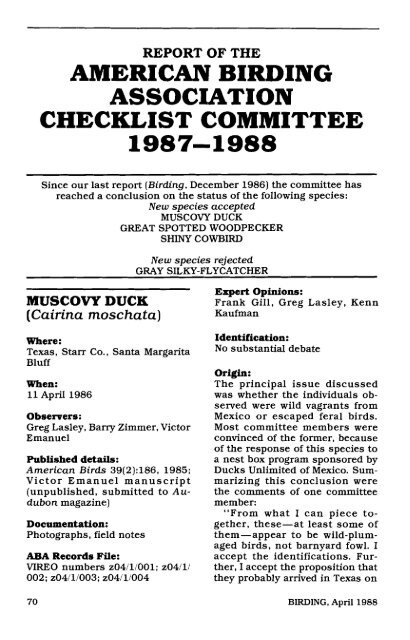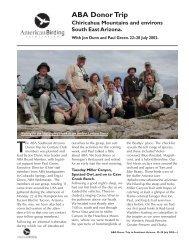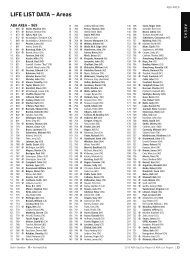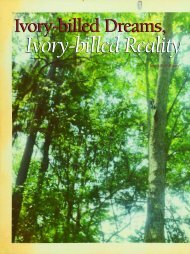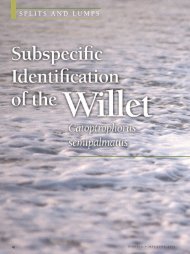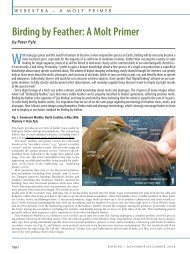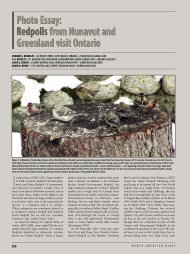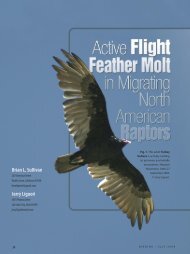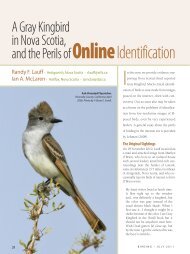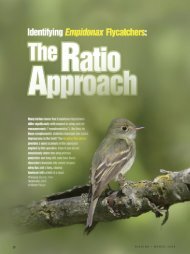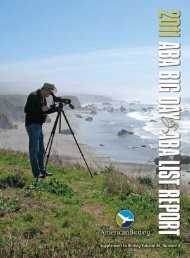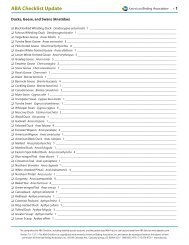1987-1988 - American Birding Association
1987-1988 - American Birding Association
1987-1988 - American Birding Association
Create successful ePaper yourself
Turn your PDF publications into a flip-book with our unique Google optimized e-Paper software.
REPORT OF THEAMERICAN BIRDINGASSOCIATIONCHECKLIST COMMITTEE<strong>1987</strong>-<strong>1988</strong>Since our last report (<strong>Birding</strong>, December 1986) the committee hasreached a conclusion on the status of the following species:New species acceptedMUSCOW DUCKGREAT SPOTTED WOODPECKERSHINY COWBIRDNew species rejectedGRAY SILKY-FLYCATCHERMUSCOVY DUCK(Cairina moschata)Where:Texas, Starr Co., Santa MargaritaBluffWhen:11 April 1986Obsemers:Greg Lasley, Barry Zimmer, VictorEmanuelPublished details:<strong>American</strong> Birds 39(2):186, 1985;Victor Emanuel manuscript(unpublished, submitted to Audubonmagazine)Documentation:Photographs, field notesABA Records File:VIREO numbers ~04111001; ~04111002; z04111003; ~04111004Expert Opinions:Frank Gill, Greg Lasley, KennKaufmanIdentification:No substantial debateOrigin:~h~ principal issue discussedwas whether the individuals observedwere wild vagrants fromMexico or escaped feral birds.Most committee members wereconvinced of the former, becauseof the response of this species toa nest box program sponsored byDucks Unlimited of Mexico. Summarizingthis conclusion werethe comments of one committeemember:"From what I can piece together,these-at least some ofthem-appear to be wild-plumagedbirds, not barnyard fowl. Iaccept the identifications. Further,I accept the proposition thatthey probably arrived in Texas onBIRDING, April <strong>1988</strong>
Photo: H Brokawtheir own, without human transport,and thus are wild in thatsense.The only question I would haveis, does the nest box programconstitute some sort of humanagency that would disqualifythese records? After some consideration,I have decided that therecords should be accepted. Fromwhat I can discover, no birds wereintroduced, which would haveconstituted a reintroduction andperhaps provided a valid argumentagainst acceptance at thistime (a reintroduction would haveto become established over a periodof time; e.g., the White-tailedPtarmigan in California). Instead,man has simply provided the necessaryhabitat (admittedly boxes,not trees) and the birds havespread on their own into thisnewly created "habitat" Had wemanaged to provide large treeswith holes, as existed in the past,the result would have been thesame."Nevertheless, I am open tonegative arguments of this sort,and I think the Committee needsto address this problem. Certainlyman has played an important rolein the occurrence of Muscovy inTexas. "Motion to add:GillIKaufmanDissenting Opinions:"The evidence in favor of consideringthe Starr Co. Muscovy Duckrecords as pertaining to wildbirds is strong, but not 100% convincing.. . and I have to be 100%convinced to vote for addition of aspecies to the North <strong>American</strong>list The reason that I am not convincedis that the records couldall pertain to a pair of feral birdsthat act like truly wild birds andVolume XX, Number 2
successfully bred, producing theimmature noted in April 1986. Althoughthe likelihood of thisseems small, such a 'devil's advocatehypothesis' cannot be excludedas far as I can see."Steve Cardiff and Donna Dittmannsaw an all-black MuscovyDuck fly across 1-10 near Lafayette,Louisiana, last year, so,we cannot state categorically thatflying, all-black Muscovy Ducksmust be of natural origin. Addingto the dilemma are free-flying,clearly feral (some white on head)Muscovy Ducks that inhabit theRio Grande Valley."My 'gut feeling' is that theTexas Muscovies are wild birds.Hopefully, a deluge of additionalrecords will soon refute the feralhypothesis."GREAT SPOTTEDWOODPECKER(Dendrocopos major)Where:Alaska, Attu IslandWhen:27 April 1986Observers:George F. WagnerPublished details:NoneDocumentation:Specimen on deposit in the Universityof Alaska museum (No.5337, subspecies D.m. kamtschaticus)ABA Records File:Photographs of specimen, VIREOnumbers v01141001, v01141002,vo 1141003~x~ert'0~inion:Richard BanksIdentification:No debateOrigin:Fall vagrant. One committeemember's analysis follows:"The problem is one of means-did the bird arrive naturally orwas it assisted? The biggest questionis, would a nomadic bird likethis be likely to fly 400 miles overwater? While I find it hard to believethat a woodpecker would, atleast three other "nomadic"species (Eurasian Bullfinch,Common Redpoll, Pine Grosbeak)have reached Attu. While the argumentsabove are far from conclusive,I believe the likelihood ofnatural occurrence outweightsthe chances of it having hitched aride all the way from coast to island.It might have rested on aboat, but it might also have restedon the Commander Islands. Awoodpecker probably would findnothing to eat on a boat andwould leave it "Motion to add:GibsonlGillVote:710BIRDING, April <strong>1988</strong>
SHINY COWBIRD(Molothrusbonariensis)Where:Florida, Monroe Co., Lower MatecumbeKey and IslamoradaWhen:June 1985, June 1986, and subsequentlyObservers:Alexander Sprunt IV, Karen Sunderland.P. William SmithPublished details:<strong>American</strong> Birds 41(3):370-371,<strong>1987</strong>ABA Records File:VIREO numbers s 14/2/001-003Expert Opinions:CommitteeIdentification:No debateOrigin:No debate; appearance in Floridapredicted from current expansionthroughout CaribbeanMotion to add:GillIKaufmanVote:710Documentation:Published photographsPhoto J Dunning, ViREOVolume XX, Number 2
GRAY SILKY-FLY-CATCHER(Ptilogonys cinereus)Where:Texas, Cameron County, LagunaAtascosa National Wildlife RefugeWhen:31 October 1985IObservers:Greg Lasley and Thomas PincelliPublished details:<strong>Birding</strong> 18(1):34-36, 1986Documentation:Published photographsABA Records File:VIREO numbers 107151001, 107151 1002Expert Opinions:CommitteeIdentification:No debateOrigin:An extended debate centered onwhether this individual was a naturalvagrant or an escaped cagedbird. Although the record wasfrom a location that has producedmany exciting finds, this sedentaryspecies has no known historyof vagrancy. It is, however, aknown Mexican caged bird. Compoundingthis concern was themolting tail, which was clearly evidentin the photo. Perhaps, someconceded, this species will proveto be a local migrant that couldwander across the border, but asa rule passerine birds don't moltPhoto: Nick Jackson, VIREOwhile migrating. More likely, theyargued, this bird lost its tailfeathers as a captive. In additionto being an abnormal passerinethat appeared to be molting whilemigrating, the individual in questionwas molting at the wrongtime of the year. August is thenormal time, not late October.Caged birds often accidentallylose and replace their tails. Afterfour votes, this view prevailed,and the species was rejected.Motion to add:GillIKaufmanBIRDING, April <strong>1988</strong>
Dissenting Opinion:"As I've already said, I'm notswayed by the issue of tail molton this bird. And at places inMexico that I've visited repeatedlyI've seen enough variation innumbers to believe that thesebirds move around somewhat Forthese reasons, I still believe thereis a good chance the Texas birdwas wild. But Binford knows thespecies better than I do, and Ihave to agree with most ofRemsen's points, so I won't voteto accept this time."Parenthetically, I think thespecies may be sufficiently irregularin its "normal" movementsthat -it will be hard to establishany regular pattern of vagrancy.Look at the scattershot pattern oflong-distance vagrancy in Phainopepla,to cite a species with somesimilarities. Since Gray Silkiesare often more gregarious thanPhainopeplas, our best chance forbelieving a US record might bewith a small flock in the Chisos orthe Chiricahuas; but I wouldn'twant to guess what time of yearthey might show up!"VOTES IN PROGRESSGREEN PARAKEET (Aratinga ho-1ochlora)-enlistMOTTLED OWL (Ciccalsa virgata)-enlistAZURE GALLINULE (Porphy rulaflavirostus)-enlistCRANE HAWK (Geranospizacaeru1escens)- enlistYELLOW-BREASTED BUNTING(Ernberiza aureola)-enlistMUGIMAKI FLYCATCHER (Ficedularnugirnaki)-remove fromlistFUTURE VOTESWEDGE-TAILED SHEARWATER(Puffinus pacificus)-in reviewSOLANDER'S PETREL (Pterodrornaso1andri)-await state(CA) decisionSWALLOW-TAILED GULL(Creagrus furcatus)-await state(CA) decisionGRAY GULL (Larus modestus)-await state (LA) decisionXANTUS' HUMMINGBIRD (Hy10-charis xantusii)-await state(CA) decisionCOX'S SANDPIPER (Caliris pararnelarotos)-Beforewe can formallyconsider this record, wemust await a taxonomic decisionfrom the AOU Check-list Committee,specifically whether it willbe accorded species status.ABA AND THEAOU CHECKLISTS:CONCORDANCE ANDCOLLECTINGSome ABA members have expressedconcern about discrepanciesbetween the <strong>American</strong> Ornithologists'Union (AOU) Checklistand the ABA checklist Somesuggest that we accept only whatAOU accepts. As Chairman of thiscommittee I disagree, both inprinciple and in practice. A fewyears ago much duplication of effortexisted. Now the AOU ChecklistCommittee relies on us (ABA)for critical reviews of possible additionsto their checklist. Ourpartnership involves the birdingcommunity in ornithology in apositive and complementary way.Volume XX, Number 2
We prepare the files, or inheritthem from state records committees,and make our decisions,which the AOU committee thenconsiders. Burt L. Monroe,Chairman of the AOU Check-listCommittee, receives copies of ourfiles and discussion. Just as theABA committee usually yields atfirst pass to state or provincialcommittees, so the AOU typicallyyields to us. It is unlikely the AOUwould accept anything we reject,but they retain the option of rejectingour positive decisions.This is as it should be, becausethe purposes of the two checklistsboth overlap and differslightly. The AOU Checklist is aconservative statement of scientificknowledge; the ABA Checklist,a summary of birding recordsscrutinized by experts. Differentcriteria and perspectives guidethe decisions of these two committeesas they debate fact versusfiction, and biological versus artificialvagrancy. Collected specimensand verifiable photographsare valued by both committees asthe best possible documentation.Pete Dunne has writtenstrongly against any further collectingof specimens to documentthe distribution of birds (seeLiving Bird Quarterly, Vol. 7, No.2) and has also lambasted "theAOU's advocacy of specimenrecords for inclusion in the North<strong>American</strong> list as an anachronismpredicated upon a philosophythat died over 60 years ago." Aschairman of this committee, andalso Vice-president of the AOUlast year, I felt obliged to reply onbehalf of the many who do notagree with Pete. My reply appearsin the October <strong>1988</strong> issue ofLiving Bird Quarterly, but thefinal paragraph merits reprintinghere (with permission from managingeditor, Richard E. Bonney,Jr.):"We must remind ourselves ofthe purpose of the AOU Checklist,which Pete challenges as irrelevantand archaic. This premierchecklist documents whatare the facts about the distributionof North <strong>American</strong> (and Central<strong>American</strong>) bird species. Compiledcarefully by experts of considerablestature, it is, and shouldalways be, a conservative document,not prone to speculation orto acceptance of uncertainties,which then will have to bechanged in future editions. Reasonabledoubt opposes the conclusionof fact, and so results inthe rejection of some records.Facts also must be verifiable inthe future, hence the need forgood documentation-photographs,tape recordings, or specimens-thatpermit expert scrutinyand bear up to critical challenge.Otherwise, we would baseour science on fiction, on possiblemyth. Certainly, with the adventof extraordinary binocularsand cameras, specimens droppedby shotguns no longer must prevailas a means of identification orverification. At times, however, aspecimen will be desirable andeven essential to confirm an identification,to separate fact fromfiction. So I suggest that we allornithologists,birders, and superbirdersalike-humbly recognizeour limited skills and our occasionalfallibility. If we do,birding and ornithology both willprosper. "Frank B. GillChairman, ABA ChecklistCommitteeBIRDING, April <strong>1988</strong>


